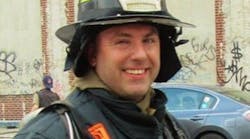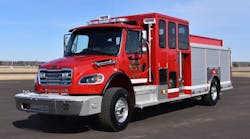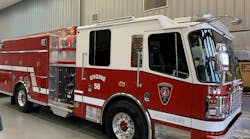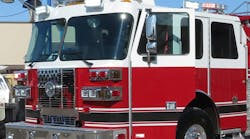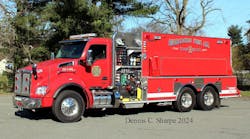As we go to press, a fire apparatus in Kentucky has fallen through a collapsed bridge. In that incident, two firefighters were injured while responding to a fire involving an abandoned house. The engine in which they were riding fell into a creek while crossing a bridge that collapsed.
Recently, a tractor-drawn aerial ladder (also referred to as a TDA or a tiller) was involved in an accident in Philadelphia, PA. The tiller enclosure was nearly knocked off when the apparatus traveled beneath an underpass. The truck made it through with the exception of the tiller enclosure.
Both apparatus appeared to have been built prior to the 2009 revision to National Fire Protection Association (NFPA) 1901, Standard for Automotive Fire Apparatus. That standard requires that visible to the driver should be a plate or label that lists the overall length, overall height and weight of the apparatus fully loaded. The premise behind the information was to give the driver vital information needed before negotiating bridges, underpasses and other potential obstacles and to promote safe operation. Although older apparatus are not required by the standard to be retro-fitted, perhaps it would be a good idea for fire departments to measure and weigh apparatus and provide this information to their drivers to prevent accidents in the future.
Overweight apparatus
We recently weighed 38 fire trucks during fleet evaluations and a majority of those trucks were overweight. It is interesting to note that one of those trucks was brand new and was overweight by 400 pounds when it left the factory for delivery. The apparatus did not have any of the 2,000 pounds of equipment on it that the unit was engineered for nor did it have any firefighters in it, which would account for an additional 1,250 pounds as it had five seating positions. This apparatus has the potential to be at least 3,650 pounds overweight.
There have been several incidents involving fire apparatus with tire failures, axles snapping, reported brake problems and mechanical issues. With the fire apparatus “obesity” problems that we have uncovered, one must wonder whether, had these aforementioned incidents been properly and fully investigated, would anyone have found overweight apparatus as being the root cause?
The standard is clear: NFPA 1911, Standard for the Inspection, Maintenance, Testing and Retirement of In-Service Automotive Fire Apparatus, Section 16.2.3, states that all fire apparatus must be weighed annually with records kept.
There are some fire departments and some fire department members in leadership positions who choose to ignore or disregard NFPA standards and they do so at great personal and organizational peril. On Sept. 15, 2001, four days after our world changed forever on 9/11, an assistant chief in New York State took his company to an acquired structure for fire department training and proceeded to break and/or disregard most of the rules outlined in the NFPA 1403, Standard on Live-Fire Training Evolutions. As a result, one firefighter was killed, two were seriously injured and the fire chief was jailed. What makes this noteworthy is that for years, the NFPA standards were used in civil courts for firefighters to sue firefighters or for civilians to sue firefighters, but until that incident, NFPA standards had not been used in a criminal proceeding to put one of us in jail. But that is exactly what occurred – the assistant chief served jail time in conjunction with that fatal fire.
As it relates to emergency vehicle operations, the following NFPA standards wholly or in part apply to driving: the above-mentioned NFPA 1901 and NFPA 1911; NFPA 1002, Standard for Fire Apparatus Driver/Operator Professional Qualifications; NFPA 1451, Standard for a Fire and Emergency Services Vehicle Operations Training Program; and some sections of NFPA 1500 Standard on Fire Department Occupational Safety and Health Program. A word to the wise: anyone in a fire department leadership position (such as fire chief, company officer, fire commissioner or director) should become intimately familiar with those NFPA standards, as you may be held both civilly and criminally responsible for adhering to them.
Seasonal driving issues
It is that time of year when there are several noteworthy fire service driving issues to address.
First, animals in the deer family (white-tailed deer, mule deer, elk and moose) go into rut in the fall. During this mating time, they will be more active and are more likely to be in or crossing roadways. Please be vigilant and careful.
As the leaves fall from trees onto roadways and become wet, they can be as slippery as ice. The roadways become extremely hazardous as we try to brake and corner apparatus, especially when we are driving tender/tanker apparatus.
As the warn breezes of summer transition into the cold winds of winter, fog becomes a more common occurrence that can wreak havoc on roadways and drastically increase response times. Apparatus positioning on scene is critical during periods of fog and low visibility as we try to provide a safe work environment for our firefighters and first responders working that scene. Please go to www.respondersafety.com for more information on positioning and scene safety.
Finally, as we settle into winter, we will again have to deal with ice and snow. If long-range weather planners are correct, this winter will have above-average cold and snowfall for most of the country. Now is the time to prepare for winter operations and winter driving. Do you have chains for your apparatus? Does anyone know how to put them on? Have you trained your drivers on driving with chains, which is much different than normal driving? Do you have rock salt and do you carry it on the apparatus? It is a good idea, as well as carrying shovels in case a vehicle becomes stuck. Have you trained drivers to drive apparatus in the snow? Don’t put additional pressure on your drivers by making their first snow driving experience a “code three” response experience.
This column could be/should be the subject of a company drill period as we enter into this difficult driving period.
Michael Wilbur presents “What Have We Learned?” at Firehouse World 2015.

